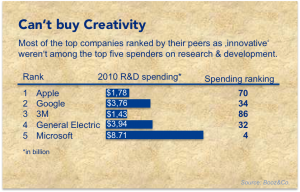[restrict]
Part 2 – Innovation and its place in the modern organization
One of the main characteristics and goals of the entrepreneurial organization is the ability to think forward and have a vision for the future. This allows the leaders behind it to come up with novel offerings, production processes, business model settings, and a variety of other organizational features that help pave the way to achieving that vision.
The key to all that, the factor that makes it all possible is innovation. So what exactly is innovation? There are many ways to look at it and many people have the wrong idea as to how to go about it. Your organization does not need to come up with the next iPhone in order to be considered innovative. Innovation could be exercised on a much smaller scale and still be considered a valuable asset to the company by making use of the entrepreneurial way of thinking.
The simple way to define innovation is novel idea + commercialization. This helps distinguish being innovative from just being creative or original thinking. Even the greatest ideas would be worthless to an organization if they do not contribute to its development by bringing new customers, optimizing processes, or help achieve other company interests. However, when done properly innovation could bring immense benefits to any organization regardless of its size or market power. Innovation has the power to fully disturb the existing market and throw it out of its current path in a completely new direction.
That is the reason why classic entrepreneurs who usually operate on a smaller scale put such a great emphasis on innovation. It could prove to be a fast lane ticket into market leadership by eliminating the size disadvantage. Innovation is however, not by any means only a small business strategy. Quite the opposite and contrary to popular believe many large corporations are actually incredibly innovative. They achieve this by implementing entrepreneurial management into their structure and operations. Following its guidelines they adjust their company leadership into a more proactive and novel thinking stance.
Investing heavily in R&D does not make you innovative
Unfortunately, there is no manual or checklist on how to be innovative. Albert Szent-Györgyi, a famous physiologist and a Nobel Prize winner, once said that discovery of new ideas is seeing what everybody else has seen and thinking what nobody else has thought. This of course is hardly something you can learn to do. You have to be born with it. There are however ways, which help raise the chances of coming up with innovative ideas. Many big corporations make the mistake of thinking that investing billions into R&D is the answer to doing just that. This however, has been proven wrong. The companies that are nowadays considered to be the most innovative are far from being the biggest spenders on R&D (Fig. 1).
So no, innovation cannot be bought. It can however, be managed. An example of that is the Stage –Gate model developed by Robert Cooper. It depicts the ideal innovation process and guides the way to success by defining the important milestones in it. Innovation is of course in reality almost never linear or standard enough to be put into a single model but the Stage – Gate model at least outlines the way and it could be a valuable tool to the entrepreneurial organization.
Focus on what first?
Another way to facilitate the innovation process and increase the chances of an innovation being successful is to focus on another core characteristic of the entrepreneurial organization – the customer comes first. Entrepreneurial managers design every aspect of the organization with the customer in mind. This outside-in approach focuses on creating value for the customer first before pleasing the company’s shareholders. This way of thinking could also be applied to innovation. The single most important factor that determines whether innovation is going to be successful or not, is the way it is perceived by the customer.
Many traditional organizations are convinced that if they build the perfect product from an engineering perspective it must be a hit on the market. That is simply not true. The success of an innovation, regardless of it being a new product, new process, or a new way of doing business, depends on the value it creates for the customer. This is exactly the area in which the entrepreneurial management organization excels. For it the customer always comes first. Its whole structure by default revolves around creating value for the end consumer. This is the reason why innovation is such a great strategy for entrepreneurial leaders. Their organization is already designed with the single most important factor for innovation success in mind – the customer.
Innovation may seem as something abstract and elusive to many managers but it does not have to be. As mentioned above, innovation is something, that could be managed and does not necessary require billions of investment in fancy offshore R&D departments in order to be achieved.
Innovation is a strategy that could be applied in any organizational context by having an entrepreneurial mindset and satisfying one of the main requirements of the entrepreneurial management organization – putting the customer in the center.
Download
You can download the brochures to our EM-series here:
EM-Blog, Part 1 – Thinking like an Entrepreneur
EM-Blog, Part 2 – Innovation and its place in the modern organization
[/restrict]
Coming soon…
Coming soon – next parts of the Entrepreneurial Management Series:
Part 3 – Firm design – a customer-centered approach
Part 4 – Social media and its important role in the EM organization
Follow the blog series…
Want to follow the whole blog series? Please register at member services.
